LESSON 7: THE ROPE AND TAPE PRINCIPLE
This lesson, which we are about to study, is long and detailed. It is not difficult but it requires careful study and attention to each minute description. You learn a wonderful tape and rope principle and five excellent effects based on this principle.
Because of the length of the lesson and the time required to study it thoroughly, I will dispense with any preliminary discussion and lead you right into your actual work.
In your next lesson I will complete for you the History of Magic by tracing Magic's Relation to other Sciences which I have not covered in previous lessons.
THE ROPE AND TAPE PRINCIPLE
The rope and tape principle, which I teach you in this lesson, is one of the oldest principles in the realm of Magic. We have evidence that this principle was in use over 350 years ago, and for how many centuries before that time this principle was employed by magicians we can only guess. It is probable that this principle was handed down from the ancient Hindu magicians for the Hindu fakirs today do similar effects with two small ropes and one, two, or three wooden balls.
The first modern version of this secret we find in a pocket effect known as "Grandmother's Necklace," in which three wooden beads are threaded on two strings, the strings knotted, and the beads finally removed from these strings held by two spectators, without doing anything to the string.
Then some genius thought of working this principle on a bigger scale. David Devant, the great English magician, says about the modern effect with the rope and tape principle, "No one knows the name of the genius who first thought of doing this trick on a bigger scale, but there can be no doubt that the magician, whoever he was, was certainly a genius."
The five effects which I give you, based on this one important principle, are:
Coats, Tapes, and Rings—in which you use two boys from the audience.
Coat, Ropes, and Rings—a simpler version of the first effect.
The Prisoner's Escape or Hanging Oneself with Ropes— which is in the repertoire of almost every street salesman, side-show man, and medicine show trooper from the South Sea Islands to Alaska.
The Magic Orange—which is a modification of the Hindu Ball and Rope effect.
Walking Through Tapes—another interesting use of the double tape principle.
1. COATS, TAPES, AND RINGS
EFFECT:
Two boys are asked to come up on the stage to assist with the experiment. Each boy is given a piece of tape about sixteen feet long to examine. One boy is asked to remove his coat. The performer passes the two pieces of tape through the sleeves and then ties the tapes in a single knot. Two examined rings are then slid down on the tape to the single knot and another knot is tied over the rings. The other boy is asked to take off his coat and performer passes the two pieces of tape through the sleeves of the second coat and ties another knot in the tapes. The ends of the tapes are given to the boys to hold. Then in a few moments performer removes the first coat, then the rings, and finally the second coat, leaving the tapes intact stretched between the two boys.
PARAPHERNALIA:
1--Two pieces of black tape, about 16 to 18 feet long and 3/4 inch wide. (You can buy rolls of tape or braid in any dry-goods or department store.) 2--A small black pin.
3--Two rings. You may use wooden curtain rings, napkin rings, harness rings, or the nickeled rings sent you with your other paraphernalia—or you may borrow two finger rings from someone in the audience.
I have in an emergency used two tea cups and threaded the tapes through the handles.
4--A table, on which to lay coats.
5--Two coats, which you borrow from boys who assist you.
SECRET AND PATTER:
To Prepare:
Have pin stuck in lower edge of right hand side of vest, head pointing downwards so that it may be removed easily, as in Figure 1.
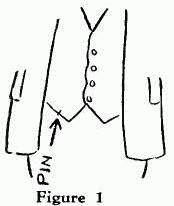
Table is in center of stage and thereon lie the two pieces of tape rolled up. The two rings may be on table or in pocket or anywhere within easy reach.
To Perform:
"For my next experiment I need the assistance of two boys." As you say this, pick up the rolls of tape from the table.
"Two of the best or two of the worst boys in the audience. There, you are just fine. And that boy over there makes the other."
Two boys come up. Have one stand at the left of you and the other at the right.
Shake hands with the boy on the left. "And may I ask what your name is?"
Whatever he says, call him by his first name.
In this instance, suppose he says, "John." "I'm mighty glad to meet you, John." Turn to boy on right.
"And your name?"
In this instance, suppose he says, "Robert." "Robert? That's fine. Have you two boys met? If they say, "No" you introduce them.
"John meet Robert. Robert meet John."
If they say, "Yes," omit the introduction. This opening is given for use when you are performing before strangers or on the stage. If at a friendly gathering, it is not necessary to use this beginning as you already know the names of the boys.
"By the way, are you the best or the worst boys? Both? Most boys are. First of all, I want you to examine two pieces of tape, each about four yards long. Look at them closely, pull on them to see that they do not break apart in some mysterious manner. John, you look at this piece and, Robert, you inspect this one."
Give an end of one tape to John and an end of the other tape to Robert.
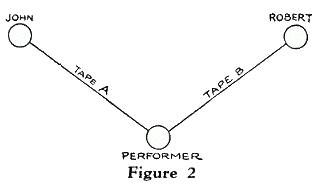
"So that everyone will be convinced that these are just two ordinary pieces of tape, each of you walk away toward the audience with your
ends and I will hold the other two ends. We'll hold the tape up so that all can see."
This brings you and the two boys into a triangular position, holding the tapes (see Figure 2). Hold tapes high so that all can see them.
"This tape also acts as a measuring tape. You can readily see that it is just as far from John or Robert to me as it is from me to John or Robert. And John, as Royal Inspector, will you give your official O.K. to the
tape? Now, both of you bring the ends of the tape to me. The exercise will do you good." Take both ends of tape and place them evenly with the two ends in your hands. Hold all four ends in left hand while right hand picks up two rings.
"You might also like to inspect these two rings. If there is a trap door in one, you tell the audience immediately—or if fire should fly out, you give the alarm at once."
After rings have been given to boys, run your right hand along the tapes until you reach the middle of them. Hold tapes at that point in left hand, and while talking, take pin from vest with right hand (see Figure 3).
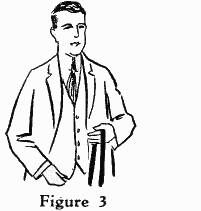
"Let Robert hold the ring and, John, if the ladies don't mind, let me have your coat. May I borrow it and do anything I want with it?"
While you are talking and John is removing coat, slip pin into tapes, fastening the two pieces together, as in Figure 4.
Then place first finger of left hand on one side of pin BETWEEN THE TAPES and thumb of left hand on the other side of pin BETWEEN TAPES, as illustrated in Figures 5 and 6. You may help your left hand get into position with the right hand if necessary. Boy is taking off coat while you are doing this, and attention of audience is drawn to him.
"John, you are going to be a big help to me."
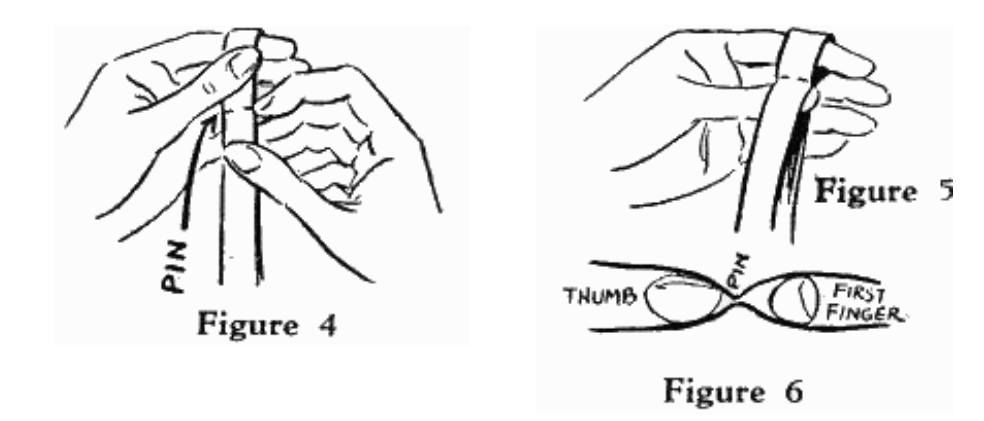
After boy has removed his coat, go towards him and reach for coat. In the meantime, your left hand drops to your side, you turn slightly to the left, and under cover of your left leg, throw Tape A forward by BRINGING LEFT THUMB UP OVER FIRST FINGER. Then remove other fingers from between tapes.
The two tapes are now doubled back, each upon itself. The joining of the tapes by the pin is covered by thumb and first finger of left hand, as in Figure 7.
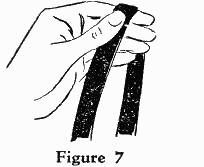
THIS IS A VERY IMPORTANT MOVE. The success of the trick hinges on this move. I want you to practice this move until you can do it speedily, easily, and smoothly so that you will not be noticed. At no time must your eyes be on the tape while you are pinning it or while you are performing the above move.
"Hold your coat front towards me and back towards yourself, and I will put the tapes through the sleeves."
As you say this, place right hand up in front of left hand and spread tapes apart, as illustrated in Figure 8. To audience it looks just as though you held the two tapes by the middle. They suspect nothing unusual. In reality, this is what you have. You started with two tapes AA and BB, as shown in Figure 9. You pinned them together at the middle and performed a move which brought AA together and BB together, as in Figure 10. Thus instead of having one end of each tape together, you have two ends of one tape together.
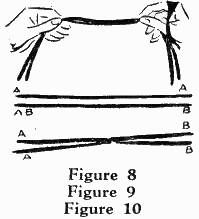
"I will thread these two ends into and through the right sleeve. Reach up the sleeve, Robert, and pull down the two ends."
Thread the two ends of tape on right side into the right coat sleeve and pull all the way through. Figure 11 shows threading of tape into sleeve. Then cover left hand with right hand and take joining of tapes in right hand. Audience will not see joining as it is covered by right hand.
"And these two ends through the left sleeve. Reach up and get these two ends too, Robert."
Then thread other two ends of tapes through the left sleeve of coat. Figure 12 shows tape threaded into sleeves.
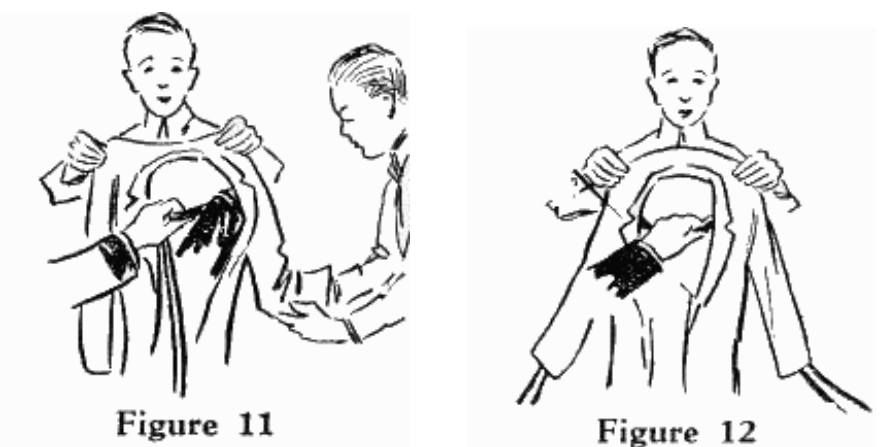
Progress so far with effect is shown in illustration.
Then take coat from boy with left hand, grasping coat by the collar. Turn back of coat to audience and then release hold on tapes. To the spectators it looks as though coat is threaded securely on two tapes.
"You are convinced, Robert, are you not, that John's coat is well threaded on the tapes? I will just lay the coat on the table so that I can tie the coat on."
Lay coat on table, open side down. Pick up the four ends of tapes and tie a single knot, bringing ends of sleeves close together, as illustrated in Figure 13.

"I had to muss the coat up a bit but I couldn't very well tie a knot without doing that. I know, however, that your tailor will not mind, and you certainly don't, do you, John? I always ask permission to do it afterwards as it is much safer. Now, Robert, give John a ring and you take one, and each of you thread a ring on two ends of the tape and have a race to the winning-post. Just slide them down. The knot is the winning-post."
Boys slip rings onto tape and push them down to knot. See Figure 14.
"Now I will tie another half knot, making a complete knot. And, Robert, by the way, may I borrow your coat? I guess you haven't anything breakable in your pockets, have you?"
Take coat from Robert and hold it for a moment.
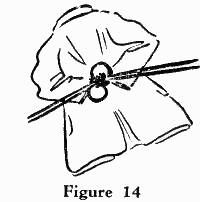
"I was doing this trick the other night and a boy had a bottle of sticky medicine in his pocket. The cork came out of the bottle and so did most of the medicine—and a good time was had by all. The boy got well. He thought he'd take his medicine with the party instead of afterwards all alone. Only last night a gentleman was helping me and he had a bottle in his pocket that he said was medicine."
Thread coat onto tapes in the same way that you did the first coat— two ends of tape through left sleeve and two ends through right sleeve.
"There the second coat is on the tapes. John, you hold two ends."
Have John stand at your left and give him tapes coming out of coat sleeve nearest him.
"Robert, you hold the other two ends."
Have Robert stand at right and give him the other two tapes coming from the other sleeve. Boys should be several feet apart so that audience can readily see performer and coats. Turn to John. "Please give me one of your ends. Either one will do." Take one of the ends from John.
"And, Robert, give me either one of your pieces of tape."
Take one of the ends from Robert. Tie a single knot with these two ends, as in Figure 15. Thus far you have the tapes threaded through one coat, a single knot tied, two rings threaded on the tapes, another single knot tied, a second coat threaded on, and a third single knot tied.
"I'm going to tie one more knot and this I will leave in full view of everyone. See, Robert, your coat is now all mussed up like John's. May I muss your coat, Robert? Thank you. Robert, hold an end of the tape again."
Give an end of tape to Robert.
"John, hold this end together with your other end." Give other end to John.
The reason for tying the last single knot is to exchange ends of the tapes and give Robert the end that John held, and John the end that Robert held.
Now each boy is holding A and B ends of tapes instead of AA and BB as formerly.

"Now to test your powers of observation. Tell me confidentially which went on the tapes first, the coat or the rings."
As you say this, reach under John's coat, which is the one underneath, and take out the pin which holds the tapes together. Stick the pin into your left coat sleeve under cover of John's coat.
"Rings? Did I hear someone say rings? I generally find rings are mentioned by the ladies. Most of them are much interested in rings. Don't laugh, Robert, you'll find it is a very serious matter some day. Well, John's coat went on first, then the rings, then Robert's coat—so if John's coat went on first, we will take it off first. You are holding your two ends, aren't you? And you are holding your two ends, aren't you? Now then, onetwo—Don't look so serious, John. It may come out all right. One-two-three—there's the coat."
Take coat off tapes. This, of course, is very easy to do. Coats should be raised off of table, holding bundle with left hand and John's coat with right hand. After you have removed bottom coat, give it to John, who can hold it over his arm.
"Just have a look at it, John, and see that I have not torn it to pieces and then sewed it together again. All right? Now for the rings. Robert, would you know your ring if you saw it again? You wouldn't. I had you look at it in the first place so you would know it again. Well, here it is. It must be yours because it has a hole in the middle and, John, the other one must be yours."
In removing rings you may let coat fall on table if you desire. Be careful that ends of tape under coat are never visible to audience. When rings are removed, give one to each boy to examine.
EXERCISE GREAT CARE AT THIS STAGE. There is danger of the boys suddenly pulling on ends of tape and bringing the trick to a premature conclusion. To prevent such a catastrophe, after rings have been removed and all knots have been untied, insert your first or second finger of left hand in one loop of tape and thumb of left hand in the other loop and hold them tight together, as illustrated in Figure 16. Ask boys to pull a little if there is unnecessary slack in tapes.

"We still have Robert's coat on the tapes. I should like to have both of you boys pull hard on the tapes when I say, Three. Don't pull until I say, Three. If you do, you may pull the whole back of the coat out. Robert wouldn't like to have the back of his coat so removed. Are you ready? You can all see the knot in the middle? Now, one-two—"
Hesitate a moment here. The boys will probably pull hard even though you haven't said "Three," because they expected you to say it.
"No, I didn't say three. Something happened anyway. Just a few stitches in the arm. But what's a few stitches between friends, eh, Robert? There's the knot still there and you are still holding the ends of the tape. One-two— THREE!"
Illustration 17 shows effect at this stage. You are holding coat with right hand. (Your left hand is holding loops of both tapes behind coat.) There is a knot in the tapes between the sleeves. A boy at each end of tapes is holding AB and AB.

At your count of Three, boys pull and you release tapes. This move frees the coat and leaves it hanging from your right hand. The two tapes are left stretched straight between the two boys. See illustration 18.
"The coat is off and the knot has vanished and you, boys, are still here. Robert, here is your coat. Oh, the torn seam. Hocus Pocus—there, everything is all right."
Take tapes from boys and shake hands with them, if you are on a stage and boys are going back to audience. In a parlor this is not necessary.
"Good-bye, Robert. Good-bye, John. When you get married and you help your wife do the washing, you will not have to use clothes pins. You can thread the clothes on the line. Then hocus pocus, and they are off again."
When you have left stage, don't forget to replace pin in edge of vest.
NOTE: If you use men for assistants, merely vary the patter a bit to suit the occasion.
2. COAT, ROPES AND RINGS
This is a modification of the effect just described. It is worked on the same principle but is done with a number of rings, two ropes and one coat. I give you these two ways of working so that you have two methods at your command and may use the one best adapted to conditions under which you are working.
EFFECT:
Performer asks two gentlemen to come forward and assist him. He gives them six rings to examine and thread onto two pieces of rope, about four yards long each. Performer ties rings onto center of ropes with single knot. One man is asked to remove his coat. Two ends of the rope are threaded through one sleeve, and the other two ends through the other sleeve. Coat and rings are then placed over the back of a chair. Another single knot is tied with one of the ropes outside of the coat, and each gentleman is asked to hold two ends of the ropes. In a moment magician removes all six rings and the coat, leaving the ropes stretched straight between the two men.
PARAPHERNALIA:
1--Two pieces of soft white clothes line, each about four yards long.
2--A small piece of white thread.
3--Six wooden curtain rings or harness rings. These rings should be large.
4--A chair with a straight back. A dining room chair will do. 5--A borrowed coat.
SECRET AND PATTER:
To Prepare:
Place the two pieces of rope with each two ends together. Find middle of the two ropes and wrap a piece of thread (No. 50 or 60) around both ropes twice. Tie thread securely. See A in illustration 19. Now fold ropes, each back on itself, as you did the tapes in the first effect. See B and C in illustration 19.

Coil up ropes in a way that will enable you to get at the joining and one set of ends easily. Have ropes thus prepared and rings on your table ready for your performance.
To Perform:
Pick up the six rings and come forward.
"Before beginning a peculiar Hindu experiment in magic, I would like to have two gentlemen help me."
Get two gentlemen to come up from audience. If they are strangers to you, shake hands with them to make them feel comfortable. Have one stand at the right of you and the other at the left, and both a little in front of you. For convenience we will call the man at the left L and the man at the right R.
"I have six rings—six solid rings. Would you kindly examine them?" Give rings to R.
Then go over to table and pick up ropes. Cover joining of two ropes by holding ropes at that point in closed left hand. With right hand spread four ends of ropes apart so that audience can see that you just hold two ropes by the middle.
"Now that you are satisfied about the quality of the rings, will you, sir, please thread the six of them on this end of the rope?"
Give R two ends at right, picking them up with right hand.
"Both of you please hold both ends of rope securely and do not let them drop."
Slide rings up against left hand, as in Figure 20. Then under cover of both hands, slide rings together over joining of ropes until joining is in the center of the rings and is completely covered.
"Now bring up your ends so that I can tie a knot over the rings."
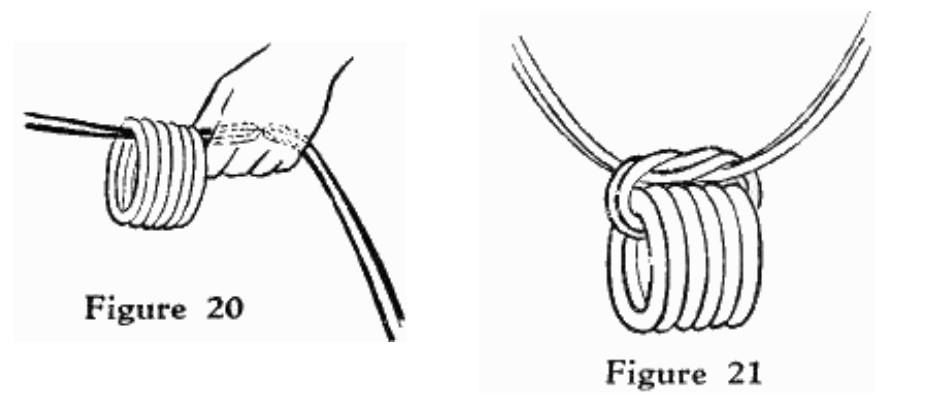
Tie a single knot over rings. Let ends fall to the floor. Illustration 21 shows knot tied.
"There, the rings are tied securely. (To gentleman on left.) And would you be so kind as to let me have your coat? I would use my own but the audience might think I have some kind of special preparation that allows my coat to fall apart and come together again."
Gentleman removes coat. If he takes things out of his pocket and transfers them to his trousers, say:
"The gentleman evidently knows me. But, sir, you may leave the articles in your coat if you choose, unless you have something breakable, such as bottles—medicine bottles. bric-a-brac, etc. Hold your coat with front toward me so that I can thread the ropes through the sleeves. (To R.) Reach up into the sleeve and pull the rope through."
You put two ends of rope inside of coat and through right sleeve and R pulls the ends out of sleeve.
"Hold the ends, sir, and tightly. These other two ends I will thread through the left sleeve and I will ask you, sir, (to L) to reach up into the sleeve and pull the ends out."
Place other two ends into inner part of left sleeve and L pulls them out of sleeve.
"Hold these two ends tightly also. We will now place coat and rings over this chair. But before doing so, I want the audience to see that the rings have been tied onto the ropes and the ropes really threaded through the coat sleeves."
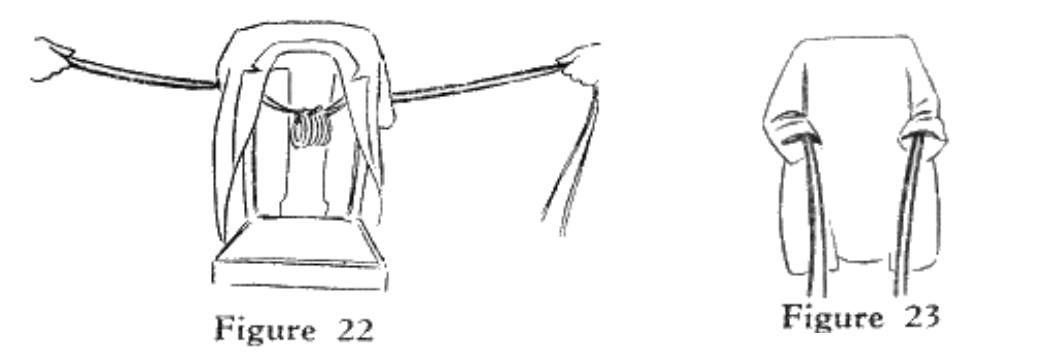
Move back towards chair. Show inside of coat with rings hanging on ropes to audience. Figure 22 illustrates coat on chair.
Chair should be placed with back to audience.
Place coat over back of chair with back of coat towards audience. See Figure 23.
"Gentlemen, each of you give me an end of one of the ropes which you are holding. Either one--you may have your choice."
Gentlemen each give you end of rope.
"I will now tie still another knot on the outside of the coat so that you can see it. It makes the coat doubly secure."
Tie a single knot with two ends of ropes. This brings the end given by L over to the right and the end given by R to the left. See Figure 24.
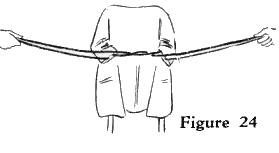
"And will you please hold the ends again?"
To the audience the knot looks like extra security but to you it is just a necessary ruse to get an end of rope held by L over to R and vice versa.
"Hold tight, but let me have just a little slack in the ropes. Do not draw them tight until I tell you to. You are thoroughly convinced, gentlemen, that the rings and coat are well secured cm the ropes and that you are holding the ends? Very well."
Reach up under coat, which screens movements of your hands. Break thread by pulling loops of ropes apart. BE CAREFUL NOT TO LET RINGS DROP. Untie the knot and insert first finger and thumb of left hand through loops of rope to prevent premature pulling of ropes from coat. Figure 25 illustrates position of fingers.
"By the way, are either of you gentlemen married? Well, do you have any trouble in getting out nights, especially when the wife locks the doors and windows? Let me give you a secret. I will show you how to go right through the door or even the roof. Just like this. Here we had six rings tied up for the evening, but look!
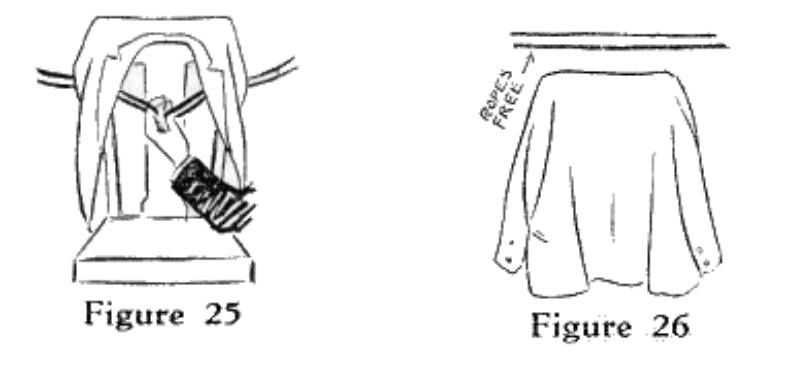
One-two-three-four-five-six--all ready to go out for a good time."
As you say this, hold up rings one at a time, passing them from left to right hand. You will find it easy to hold rings on three lower fingers of left hand before passing them to right hand.
"Will you examine them, sir, and see if the rings are all right? Didn't hurt them a bit."
Give rings to R with right hand. Meanwhile for safety, keep your hold on loops of ropes with left hand.
"That leaves us with the coat knotted on the ropes. See the knot. When I say Three, pull the ropes tight. Pull hard. One-two-THREE."
At Three, release your hold on ropes. Assistants pull ropes out of coat and the ropes are stretched straight between them. The coat remains on the chair, as in Figure 26.
"See what a little help will do in getting a friend out of trouble. Here. sir, is your coat as good as ever.
Give coat to L and take ropes.
"Now that you understand the process fully, I hope that neither of you will hesitate to go out evenings even if you are locked or tied in."
3. THE PRISONER'S ESCAPE or HANGING ONESELF WITH ROPES
EFFECT:
Performer shows two pieces of rope, each about six feet long. He then places the ropes around his neck and ties them securely. In a moment he jerks the rope off, apparently right through his neck; for when he shows the ropes, the loops, which a moment before were around his neck, are still in the ropes.
PARAPHERNALIA:
Two pieces of rope, preferably soft white clothes line -- each about 6 ft. long.
SECRET AND PATTER:
To Perform:
Bring forth the two ropes.
"Some time ago a magician was in a strange land and amongst strange people. His wanderings about the world had led him into peculiar places. Whether the people of this particular land were cannibals, Hottentots, or wild men I do not know, but when these natives saw the magician they quickly pounced on him and made him prisoner. He was led before the king, who, after some peculiar jibberish, beckoned to the Royal Executioner. The Royal Executioner thereupon took two ropes, something like these which I have here in my hands." Show ropes and give them a good pull to show that they are strong.
Then hold ropes in right hand with middle of ropes across palm of hand and ends hanging down. Now pass one of the ropes over onto left hand.
Rope now on left hand is held in a special manner. Study illustrations carefully. With back of hand toward audience, lay the middle of the rope over forefinger of left hand. Pass second finger in front of rope and third and fourth fingers behind it, as in Figure 27.
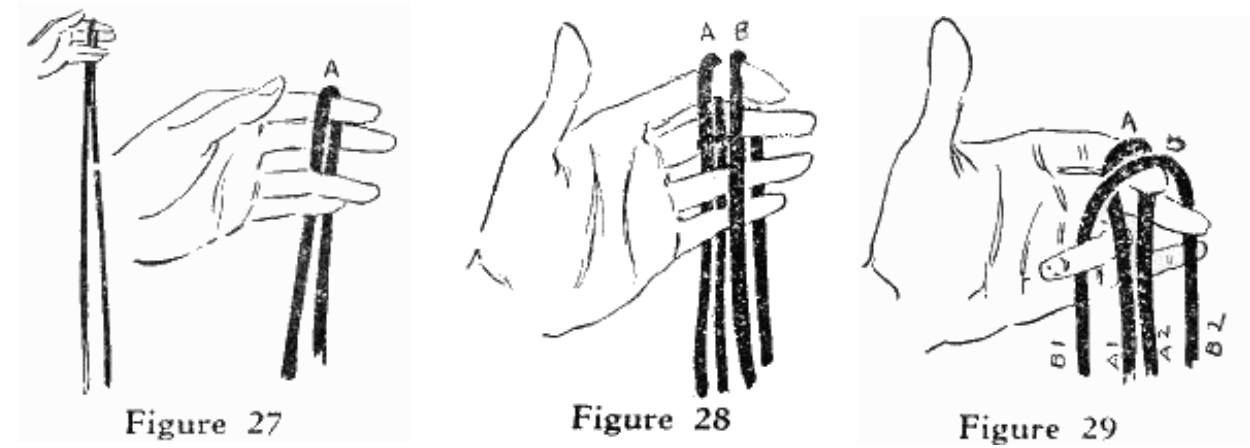
Now lay the second rope B over left forefinger so that all of your fingers are between the strands of the rope. Positions of both ropes shown in Figure 28.
PRACTICE LAYING THE ROPES ON LEFT HAND UNTIL YOU CAN GET THE ROPES INTO POSITION ALMOST AUTOMATICALLY.
"Yes, the ropes were something like these except that they were made of buckskin or certain strong grasses or fibers from the bark of trees."
Now note carefully the position of the two ropes on left hand. Study illustration 29, noting exact position of each of the fingers.
Insert third and fourth fingers of right hand between A2 and B2 and lift up A1 and A2 a little. Keep first two fingers of right hand in front of left hand to screen movements. See Figure 30, next page.
Hold third and fourth fingers of right hand right against edge of palm so that your grip on Rope A is secure. The left thumb and little finger should also have a tight grip on Rope B. See Figure 31.

Slip left second finger out of loop in Rope A and hold finger against front of Rope B. Press right thumb down on loop in Rope A, pulling loop A up and over loop in Rope B, and hold it tight between thumb and first finger of right hand, as in Figure 32. Hold other fingers of right hand close together in front of left hand to screen movements.
Slide left hand along Rope B to about a foot from joining of ropes.
This series of movements must be practiced until they can be done as one continuous movement. The forming of this fake joining of the ropes should take but a moment. Figure 33 shows ropes joined. If your movements are fast and screened with your fingers, the audience will not suspect that you are manipulating the ropes in any way. A slight swinging of the arms also helps to cover movements.
When the rope is finally held in the right hand with fake joining between first finger and thumb, back of hand to audience, spectators think you are merely holding the two ropes by the middle. Effect illustrated in Figure 34.
THE MAKING OF THIS FAKE JOINT IS, OF COURSE, THE FUNDAMENTAL MOVE IN THIS
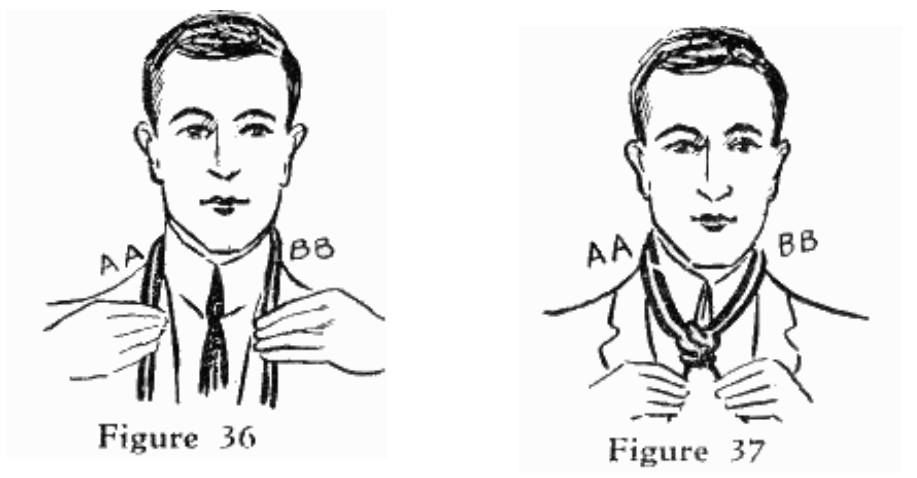
TRICK. On your skill in making this joining quickly and without detection depends your success in presenting this effect. Practice these moves before the mirror until you have mastered them.
"Then the Royal Executioner placed the ropes around the magician's neck."
Put right hand back of your neck and force joining of two ropes in between neck and collar, as in I, Figure 35. As you do this, open up loop a little (see illustration 2, Figure 35) so that loop A is not folded over B. This is done so that ropes will come apart easily when you desire to pull them off your neck. Sometimes I leave one loop bent over the other and held tight between my neck and collar so that I can jerk on the ends of the ropes to show that they are secure. Then I reach back of my neck and loosen loops. Pressure between neck and collar holds ropes in place.
You now have ropes arranged around your neck--the two ends of one over your right shoulder, and the two ends of the other over your left shoulder, with the joining at the back of your neck, as illustrated in Figure 36. The spectators, of course, think that both ropes are around your neck.
"And he tied the ropes together in several knots."
Tie the four ends of the ropes together in two or three knots, not too close to neck. See Figure 37.
"Now the magician was a magician. Tying ropes around his neck seemed serious to him, as he thought they might hang him. He grasped the ropes with his hands and tried to get them off over his head, but he found that they were tied too tight for that."
Show ropes well tied around your neck. Then place right thumb between ropes A and A and between B and B. Grasp two upper ropes A and B by closing first two fingers around them.
Insert first two fingers of left hand between the same ropes but under right hand. Grasp two lower ropes A and B firmly with these two fingers, as in Figure 38.
The knots in the ropes should be far enough away from your neck to do this comfortably.
"Then he knew he would have to call on his magic power to aid him. He let out a yell that startled the king and then he uttered slowly some startling syllables which neither he nor the king knew. And then he gave the ropes a jerk."
Jerk ropes and, as you do so, spread the two ropes apart into loops, as illustrated in Figure 39. The illusion is that the ropes came right through the neck in the form of these loops. The audience thought you put the ropes around your neck and tied them together, thus forming these loops. Now when the ropes come off your neck in the form of these loops, the audience is convinced that you did put the ropes around in this manner and they are puzzled beyond words.
"And the magician was free—the ropes as solid as before. The king fell dead, the magician became king and lived happily ever after."
NOTE: This effect may be presented without patter if desired, especially if it is presented with other rope effects.
4. THE MAGIC ORANGE
This is a very interesting little experiment, similar to that performed by John Mulholland and Milton Smith, worked on the same principle as the three preceding effects. When smoothly performed and clothed with a little story, it makes an excellent trick for parlor, club, or stage.
EFFECT:
An orange with a hole punched through the middle is threaded onto two pieces of tape, each about four feet long. Tapes are tied in a single knot around the orange, and two spectators are requested to hold the ends of the tapes. At a command from the performer the orange falls from the tapes into his hands. The tapes remain stretched between the two spectators holding it and the orange is in the same condition as it was at the beginning of the effect.
PARAPHERNALIA:
1--Two pieces of tape, each about four feet long and 1/4 or 3/8 of an inch wide.
2--A bodkin or large needle into which you can thread tape and push it through orange.
3--An orange or apple. You may use either.
SECRET AND PATTER:
To Perform:
Spread out one piece of tape and on top of it lay the other piece, end to end, as in illustration 1, Figure 40. Tie a piece of thread around the middle of both tapes. Double back the top piece and double under the bottom piece. You now have the two ends of one tape AA together and the two ends of the other tape BB together, as illustrated in 2, Figure 40.
Thread BB on a bodkin that is at least four inches long. Fold tapes so that they lie in a heap on table. Be careful to have joining of tapes away from audience. See 3, Figure 40.
Have orange fixed with hole through middle, about a quarter of an inch in diameter. This hole can be made with a pointed lead pencil or a spike.
To perform:
Come forward with orange.
"I suppose most of you are familiar with fairy stories. Have you heard the story or legend about the Magic Orange? In a far away country lived a great Prince and every year he held a great fair to which farmers brought their choicest fruits for exhibit. The finest fruit was selected from this exhibit for the beautiful Princess. At this
particular exhibit, a great prize was to be given for the choicest orange in all the land." Show the orange and give it to a spectator to examine.
"I shall use this orange for the experiment. I have made a hole through it with a pencil. Examine it if you
will, sir. The reason for the hole is that it was customary to thread ribbons through the choicest of fruit so that it could be hung up and it would not be necessary for anyone to touch the fruit in examining it."
Take back the orange. Now thread it onto the tapes by pushing the bodkin through the hole in the orange, as in Figure 41. If you have no bodkin, push ends of tape through with a lead pencil.
When you pick up tapes from table, be sure that joining is well covered with left hand. See Figure 42 for correct position.
Draw the tapes through the orange with right hand until the joining is in center of orange, as illustrated in Figure 43.
I have two ways of doing the threading of the orange. One way is to pick up tape with joining covered by left hand and come down towards audience while threading orange. The other way is to bring the orange to the table in left hand, pick up bodkin with right hand and thread orange, letting the joining of the tapes remain on the table. Then I pick up the tapes at the joining with left hand and pull tapes through with right hand until joining is in center of orange. If orange is held in front of tapes, they can be drawn into orange without joining being seen even if it is not covered by left hand.
Practice ANGLES OF VISIBILITY on this before your mirror.
Remove bodkin from tapes.
"So I will thread the orange on these tapes and have it held up so that all can see it. To make it doubly secure, I will tie a knot around the orange."
Take one end of Tape A and one end of Tape B and tie a single knot with these two ends, reversing their direction. Thus your left hand now holds AB instead of AA and your right hand holds AB instead of BB, as illustrated in Figure 44. (I explained the reason for doing this in the first effect, Coats, Tapes and Rings.) Now hold orange up high.
"And so it came to pass that this fine orange won first prize. When the man came forward to claim it, the peasants were indignant, for they said, 'This man has no orchard. He is a thief. He has stolen our fruit and exhibited it.' Then many peasants claimed it as their own. Now, fortunately, the Prince was a Magician so he put a magic charm on the orange."
Now you request the assistance of two men from the audience.
"I would like to have two gentlemen to assist me so that I can find the owner of the fruit with the magic charm. Thank you, just come forward, and you also, sir. (To one). Just hold these two ends. (To other). And you, Sir, hold these two ends. Hold ends tight and do not drop them."
The men are each given two ends to hold. The audience can see the orange suspended from the tapes between the men. You stand behind the orange.
"According to the legend, the Prince said that the orange could not be removed from the ribbons by anyone but the rightful owner—that if the real owner of the orange would touch it, it would fall into his hand. One by one the peasants came forward and touched the orange, but it remained securely on the ribbons. Then came forward a young man from whose orchard the orange has really been stolen. He held his hand under the orange thus."
Hold right hand about a foot beneath the orange. Figure 45.
"Now, gentlemen, pull hard on the tapes."
When assistants pull hard, the thread holding the two tapes together breaks. The orange falls into your right hand, which is beneath it ready to catch it. The tapes are stretched out straight between the two assistants, as in Figure 46.
"And just as the Prince Magician said, when the rightful owner came the orange magically dropped from the ribbons into his hand."
Take tapes from the gentlemen and thank them. They go back to their seats.
"The moral of which is—Some people claim to be movie actors, but the nearest they get to Hollywood is eating oranges that come from there."
5. WALKING THROUGH TAPES
This is an effective version of the double rope principle and coupled with showmanship it is very puzzling.
EFFECT:
Two long tapes are freely shown and passed up under a gentleman's coat and behind him. One of the tapes is tied in a single knot in front of him to secure him still further. The ends of ropes are given to two spectators to hold, one standing at left, and other at right of gentleman who is bound. The latter is told to walk backwards with the result that the tapes instead of being behind him are now stretched in front. He has apparently walked through the two tapes.
PARAPHERNALIA:
Two long pieces of tape, each about ten feet long.
TO PREPARE:
Have tapes fixed with thread through center similar to tapes in the magic orange effect. Fold tapes back on themselves so as to form the fake joint. Place tapes on table or suit case (if you use one for performing) with fake joints concealed from audience.
SECRET AND PATTER:
To Perform:
Pick up tapes and in doing so cover the fake joint with the left hand. Allow ends of rope to fall to floor. It is easy to convince audience that you hold but two harmless pieces of tape.
Invite three gentlemen to come up and assist you.
Address the one who looks the best natured and say,
"Pardon my asking sir, but are you much of a walker? Do you take an interest in walking or would you rather ride? Most of us would. I ask this because I am going to perform an odd walking experiment. Perhaps one of the oddest you have ever encountered. I got the idea from Teddy Roosevelt. I will ask you to face the audience while I pass these two tapes behind you."
The other two assistants should be standing one at the right and another at the left. The left side of stage is to your left when you face audience.
Stand at right side of gentleman who is to be the walker and pass left hand up under his coat and behind his back, then reach around him with right hand and take tapes.
Address gentleman to left side of walker.
"Will you be kind enough to take these two ends of the tapes and hold them tightly?"
Give him the two ends in your right hand.
Address gentleman at right.
"And I will have you take these other two ends."
Release fake joint held with left hand and run hand along tapes so you can easily present the two other ends to spectator helping you.
Study diagram 47 and you will readily see position of ropes as held by assistants.
The two gentlemen on each side should be far enough away so as to take in the slack in tapes and yet not pulling hard enough to break the thread in joint. Audience should be readily able to see that man in middle stands in front of the ropes.
"Now gentlemen each of you holding the tapes, give me an end of any one that you are holding and for safety we will wrap our friend, the walker, up in the rope and tie it securely around him."
Take an end from each gentleman, tie a single knot in front of the walker and give back the opposite ends to the assistants from what they originally held. We discussed the principle thoroughly in the "boys, coats and rings."
"Gentlemen, please hold the ropes securely. Note carefully how matters stand. Two ropes extend BEHIND the gentleman in the middle and for extra good luck we tied him in one of them. but still it runs around in back of him."
To gentleman in center.
"When I say 'One—two—three—WALK' I want you to step backwards two or three steps." To men holding the tapes.
"And when you hear me say WALK I want you to pull hard. Hold onto the tapes and pull. Are you ready gentlemen?"
You should be standing a little to the right of walker and behind tapes. You can get to the position by walking around assistant on right side of stage. The main idea, of course, is to stand so you do not obstruct the view of the trick.
"It is said of Teddy Roosevelt that when he went walking he would often set out in a straight line and hew to the line in spite of obstacles. He would go over fences and through houses. But Teddy had nothing on the gentleman here. I'll show you a walker. One--two--three--WALK."
Man walks backwards, men on ends pull, thread breaks and tapes come out stretched in front of the walker.
"See, the gentleman has walked right through the tapes." To walker.
"I congratulate you, sir. You are an excellent walker. No sense going around a block when you can cut right through, is there?"
Take tapes from other two gentlemen.
ANOTHER TAPES RELEASE
Effects with this tape principle are practically endless, and a bit of thought will show you new ways of working. An effective way is to have tapes prepared with thread and folded back on each other so as to form fake joint. Then place tapes under a man's coat (joint behind his back) and bring the tapes around in front and tie a single knot. Tapes are then threaded through each sleeve. A ring is placed in each of the gentleman's hands and tapes threaded through each ring, respectively. A single knot is made with a tape from each side, and ends given to two spectators to hold. See Figure 48.
Upon pulling tapes they free themselves and become stretched out before gentleman in middle. If thread does not easily break just reach up under coat and break it.
Another way is first to thread rings on tapes then go through the routine above. Performer reaches up under coat and removes rings then has tapes drawn out. All this is done while gentleman is wearing his coat.
The Japanese magicians have a way of doing the tape release in which several persons are threaded on the tapes. In their hands the effect is very puzzling.
LESSON 8
1--A piece of red tissue paper about twelve inches square is examined and rolled into a ball. This is given to a spectator to hold. Performer now asks several members of the audience to write any numbers of three digits each on a card. Another spectator is requested to add these and call out the total. Performer then says he will transfer this number to the ball of tissue paper. The ball is unrolled and there is found the number called out.
2--A piece of examined paper is placed in an empty envelope by a member of the audience. The envelope is sealed and given to a spectator to hold. Performer takes a card and writes on it numbers called out by several spectators. These are added together. Envelope is torn open and the numbers of the sum are found to be cut out of the paper.
3--Two envelopes are shown empty. On one is written the word Bank. Performer borrows a dollar bill, telling owner to remember number on it, and puts bill in the envelope marked Bank. He gives this envelope to a spectator to hold. Magician writes a check for a dollar, places it in the other envelope, and gives this to another spectator. Performer shows how rapid banking can be done and checks cashed without bothering anyone. The two envelopes are opened and the check and the bill are found to have changed places.
TARBELL SYSTEM, INCORPORATED, Chicago.
Bạn đang đọc truyện trên: Truyen4U.Com